If inflation is hanging around, time to tune in to Future Quality
Who hasn’t sat at home, shouting at the TV as a contestant on a quiz show offers up a hopelessly wrong answer? Incredulity, frustration and a sense of helplessness are all common emotions in that situation. At least you normally get a good laugh at the end of it.
 Source: Shutterstock
Source: Shutterstock
Those emotions can often feel familiar when investing in global equities too, though it’s much less of a laughing matter if you don’t come up with the right answers for your clients. We’re definitely stretching the analogy here but if the global economy was a TV quiz show, then the chair of the US Federal Reserve (Fed) would be the most important contestant. The stakes have been raised considerably in recent years, as investors have become used to an extremely accommodative monetary policy backdrop. What happens if the Fed get the answers wrong? Probably nothing good for equity markets.
It certainly feels like the room for error is quite small. If the Fed guesses too high on inflation and starts to meaningfully reduce policy support, asset prices could fall materially. If it guesses too low and allows inflation to become entrenched, the outcome will be little better.
Chart 1: Liquidity growth drives asset prices
 Source: Bloomberg
Source: Bloomberg
The next commodity “Supercycle”?
One of the most important questions facing investors just now is whether the disinflationary forces of the last two decades have now blown themselves out, allowing a return of inflation—something that a lot of current investors have not really experienced. We doubt that we have seen the full disinflationary impact of technology and globalisation but politicians do seem to be finally deploying more expansionary fiscal policy than has been the case in recent years.
Can the combination of large government debt-sponsored infrastructure investments (especially in the US) and ongoing investment in energy transition shift the long-term supply/demand balance for commodities?
Copper has been the focal point for investors looking for the next “supercycle”. This makes sense to us. Infrastructure investment can be fairly copper-intensive and the metal is the raw material most synonymous with the electrification of the global economy; as a result, it is (relatively speaking) on the right side of the ESG debate. The case for copper sounds more plausible than in previous years, but how much more?
We are fairly sceptical about how quickly US infrastructure legislation will turn into demand for physical copper, with the amount of spending still up for debate and the planning process much more protracted than in controlled economies such as China. It is worth noting too that the world’s largest economy represents less than 10% of global copper demand. As such, a gradual uptick in US demand likely will do relatively little to alter demand globally.
Decarbonisation, however, is gaining momentum and looks more compelling to us. Politicians across the world have hopped on the electric bandwagon and optimism abounds regarding the successful delivery of the numerous targets announced. As shown below, “green” demand for copper (at 1.5 million tons) is currently about 5% of global supply but is expected to treble by the end of this decade and grow further thereafter. With copper supply threatened by grade deterioration, it is plausible that the market could be in structural deficit if nothing else changes.
But might something change? For instance, demand from China currently represents 60% of global copper demand. In the past, many observers more informed than us have (wrongly) predicted a meaningful fall in Chinese demand. However, deteriorating demographics and alternative, less raw material-intensive investment priorities from the government are very likely to lead to an eventual reduction in China’s demand for copper. Maybe analysts are tired of being wrong on China. Maybe it is just better for one’s career to feed the pathological optimism required to be an equity investor, but it seems like there is less interest in exploring the potential downside to demand in the world’s second largest economy, with most of the focus instead falling on the more exciting, future growth drivers.
Chart 2: Renewable energy may drive a long-term boom in global Copper demand
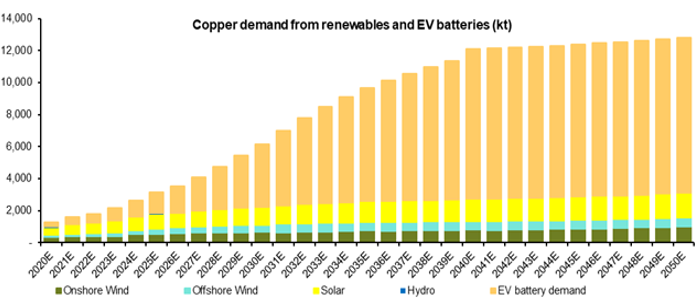 Source: Bernstein Research
Source: Bernstein Research
We believe in the long-term investment opportunities presented by climate preservation and have a number of these stocks in our portfolio (SolarEdge, JohnsonMatthey, Schneider Electric, Kingspan, Carlisle Group & Daikin, for instance). In each of these businesses, their ongoing investments in innovation and lower capital intensity should prove more attractive and provide smoother long-term cash returns on investment than the commodities that help fuel their growth.
Time will tell if this supercycle is more enduring than the one that drove rapid commodity price rises from 2004 to 2007. Inflation data over the next few months will likely add further fuel to the supercycle fire, as economies reopen, supply chains take time to adjust and prices recover from COVID-19-inspired lows.
We’re more interested in the data after these COVID-19 comps—that is, a company’s earnings relative to its performance during the height of the pandemic—have been lapped though and if and when growth in global liquidity starts to fade. Things can look great from the top of a wave but appear much more frightening on the way down, after that wave has crested. Abundant liquidity certainly provides an optimistic vantage point at present but such a situation probably won’t last forever. This time may be different but recent history suggests that the current copper price level may prove tricky to sustain as the commodity’s biggest consumer continues to tighten the monetary liquidity taps.
Chart 3: Monetary conditions in Copper’s biggest buyer still matter though
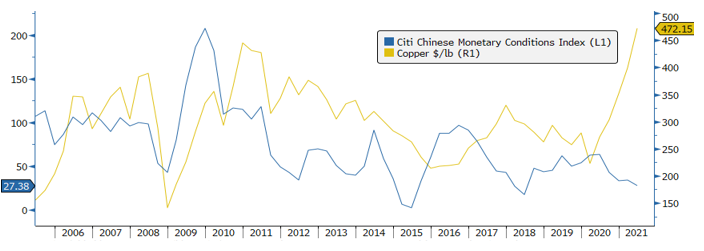 Source: Bernstein Research
Source: Bernstein Research
Reference to individual stocks is for illustration purpose only and does not guarantee their continued inclusion in the strategy’s portfolio, nor constitute a recommendation to buy or sell.
Growth at any price
Potentially imperfect views of the future are not the preserve of policy makers or commodity traders, however. Far from it. We daresay that most (if not all) clients of an asset management company have sat across a desk from their fund manager, questioning their (seemingly very confident) view of events yet to occur. This can be particularly true when selling the “next great thing”. If the global liquidity wave has lifted a lot of boats in the value style in recent months, its impact has been even more marked in growth stocks over the last few years.
Part of the reason why the rotation out of growth and into value has been relatively violent in recent months can be explained by going back to the starting point of this trade. Years of extremely low interest rates and abundant liquidity had already created fertile ground for risk taking, and when light began to flicker at the end of the COVID-19 tunnel the resulting euphoria provided the catalyst for a further, sharp increase in growth stocks.
The rapid share price appreciation starting in the summer of 2020 for newly listed companies (largely with unproven business models and even less clearly established cash generation) shown below is just one of many examples of excess that we observed in parts of the market last year. We’re not yet convinced that history will judge special purpose acquisition companies (SPACs) kindly and the ultimate value (and environmental impact) of cryptocurrencies remains a hot topic at the time of writing.
Chart 4: Investor appetite for risk boomed after initial COVID shock
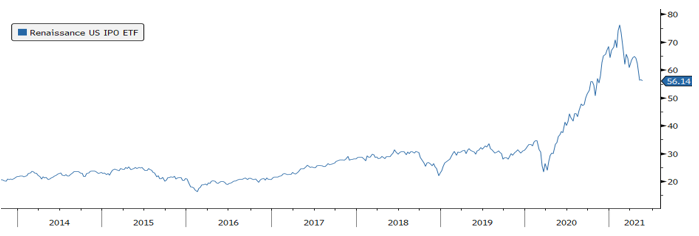 Source: Bloomberg
Source: Bloomberg
There was certainly no shortage of IPOs to invest in over the last year or so and 2021 will be a record year for IPO launches in the US. Private equity sponsors seem to see something attractive about the current environment that may not persist in the long run.
Chart 5: Asset owners were quick to respond
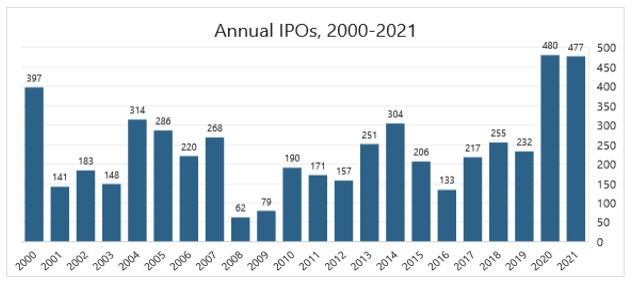 Source: Stockanalysis.com, April 2021
Source: Stockanalysis.com, April 2021
Some of these businesses will be the real deal, genuinely disrupting existing industry structures and making themselves indispensable to their customers. A lot won’t.
Even with the winners, it is very important to pay careful attention to the price that you are willing to buy them for. Valuation remains a critical pillar of our investment process. Our discipline in assessing long-term revenue growth, profitability and cash generation has seen us progressively reduce our exposure to the Information Technology sector over the last few quarters.
Chart 6: Our technology related holdings were reduced with Healthcare a key source of new ideas
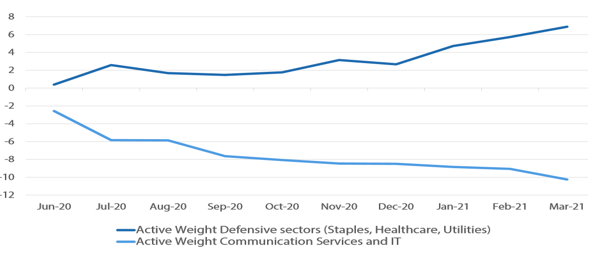 Source: Nikko AM, FactSet
Source: Nikko AM, FactSet
Conclusion
In conclusion, the inflationary tide may be turning. Certainly, the picture that we are seeing on our monitors every day looks a bit less cut and dried than it has for the last few years. Undifferentiated business models, excess competition and a lack of pricing power still pose a significant threat to the sustainability of profit margins in some value sectors though. If the cost of doing business is really increasing, being able to hold or improve your profit margins and cash returns will be key.
Rather than getting pointlessly enraged and shouting impotently at a Bloomberg terminal, we are reaching for the remote control of Future Quality, switching off the noise and focusing on trying to find companies that will deliver rising cash returns on investment, regardless of the questions posed by the macro economy.
Top ten holdings

Reference to individual stocks is for illustration purpose only and does not guarantee their continued inclusion in the strategy’s portfolio, nor constitute a recommendation to buy or sell.
Source Nikko AM as at 30 April 2021.
Strong ESG credentials
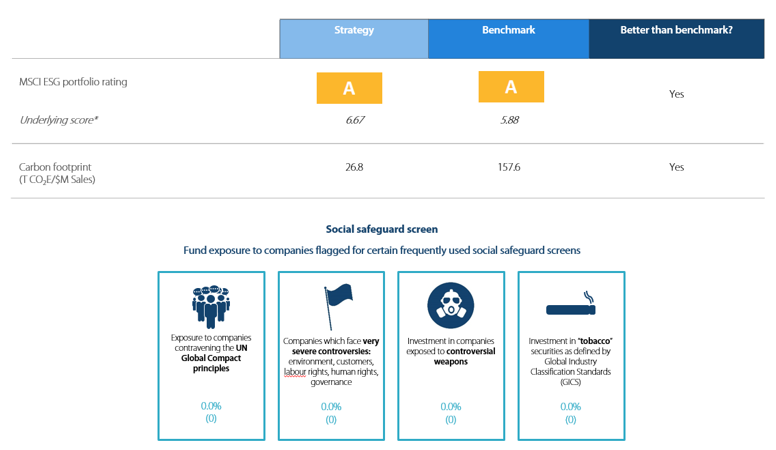 Source: MSCI ESG Research March 2021. Data supplied as per the MSCI definitions. Fund is a representative account of the Nikko AM Global Equity Strategy. Benchmark is the MSCI ACWI.
Source: MSCI ESG Research March 2021. Data supplied as per the MSCI definitions. Fund is a representative account of the Nikko AM Global Equity Strategy. Benchmark is the MSCI ACWI.
Global Equity Strategy Composite Performance to Q1 2021


*The benchmark for this composite is MSCI All Countries World Index. The benchmark was the MSCI All Countries World Index ex AU since inception of the composite to 31 March 2016. Inception date for the composite is 01 October 2014. Returns are based on Nikko AM’s (hereafter referred to as the “Firm”) Global Equity Strategy Composite returns. Returns for periods in excess of 1 year are annualised. The Firm claims compliance with the Global Investment Performance Standards (GIPS ®) and has prepared and presented this report in compliance with the GIPS. Returns are US Dollar based and are calculated gross of advisory and management fees, custodial fees and withholding taxes, but are net of transaction costs and include reinvestment of dividends and interest. Copyright © MSCI Inc. The copyright and intellectual rights to the index displayed above are the sole property of the index provider. For more details, please refer to the performance disclosures found at the end of this document. Any comparison to reference index or benchmark may have material inherent limitations and therefore should not be relied upon. Data as of 30 April 2021.
Nikko AM Global Equity: Capability profile and available funds (as at 30 April 2021)
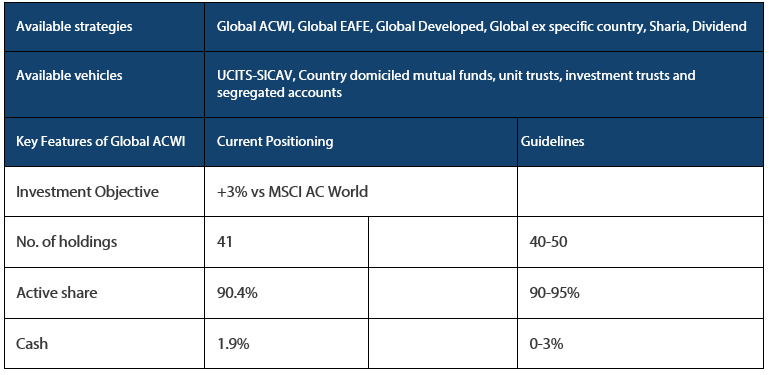
Target return is an expected level of return based on certain assumptions and/or simulations taking into account the strategy’s risk components. There can be no assurance that any stated investment objective, including target return, will be achieved and therefore should not be relied upon.
Past performance is not indicative of future performance. This is provided as supplementary information to the performance reports prepared and presented in compliance with the Global Investment Performance Standards (GIPS®). Nikko AM Representative Global Equity account. Source: Nikko AM, FactSet.
Nikko AM Global Equity Team

This Edinburgh based team provides solutions for clients seeking global exposure. Their unique approach, a combination of Experience, Future Quality and Execution, means they are continually “joining the dots” across geographies, sectors and companies, to find the opportunities that others simply don’t see.
Experience
Our five portfolio managers have an average of 24 years’ industry experience and have worked together as a Global Equity team for eight years. In 2019, two portfolio analysts, Michael Chen and Ellie Stephenson joined the team and they are the first in a new generation of talent on the path to becoming portfolio managers. The team’s deliberate flat structure fosters individual accountability and collective responsibility. It is designed to take advantage of the diversity of backgrounds and areas of specialisation to ensure the team can find the investment opportunities others don’t.
Future Quality
The team’s philosophy is based on the belief that investing in a portfolio of Future Quality companies will lead to outperformance over the long term. They define Future Quality as a business that can generate sustained growth in cash flow and improving returns on investment. They believe the rewards are greatest where these qualities are sustainable and the valuation is attractive. This concept underpins everything the team does.
Execution
Effective execution is essential to fully harness Future Quality ideas in portfolios. We combine a differentiated process with a highly collaborative culture to achieve our goal: high conviction portfolios delivering the best outcome for clients. It is this combination of extensive experience, Future Quality style and effective execution that offers a compelling and differentiated outcome for our clients.
About Nikko Asset Management
With USD 283.2 billion* under management, Nikko Asset Management is one of Asia’s largest asset managers, providing high-conviction, active fund management across a range of Equity, Fixed Income, Multi-Asset and Alternative strategies. In addition, its complementary range of passive strategies covers more than 20 indices and includes some of Asia’s largest exchange-traded funds (ETFs).
*Consolidated assets under management and sub-advisory of Nikko Asset Management and its subsidiaries as of 31 March 2021.
Risks
Emerging markets risk - the risk arising from political and institutional factors which make investments in emerging markets less liquid and subject to potential difficulties in dealing, settlement, accounting and custody.
Currency risk - this exists when the strategy invests in assets denominated in a different currency. A devaluation of the asset's currency relative to the currency of the Sub-Fund will lead to a reduction in the value of the strategy.
Operational risk - due to issues such as natural disasters, technical problems and fraud.
Liquidity risk - investments that could have a lower level of liquidity due to (extreme) market conditions or issuer-specific factors and or large redemptions of shareholders. Liquidity risk is the risk that a position in the portfolio cannot be sold, liquidated or closed at limited cost in an adequately short time frame as required to meet liabilities of the Strategy.




